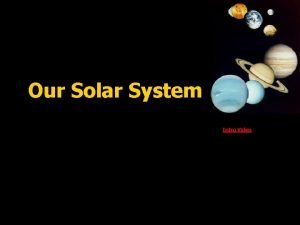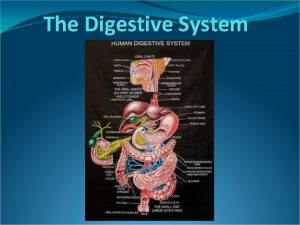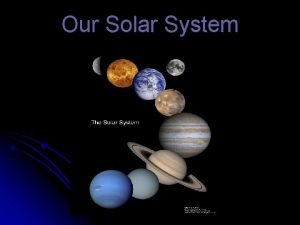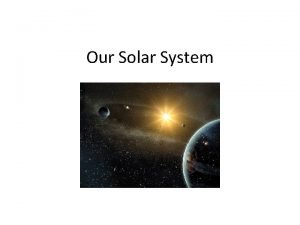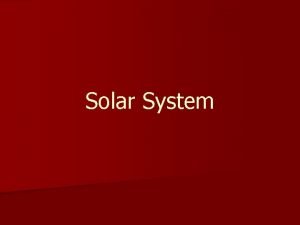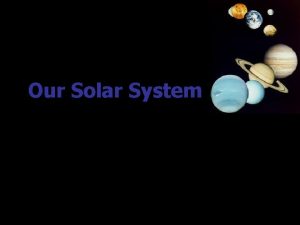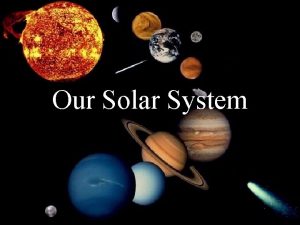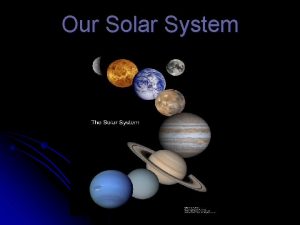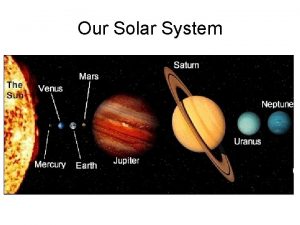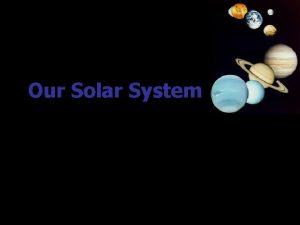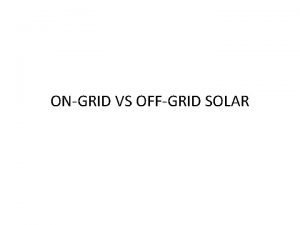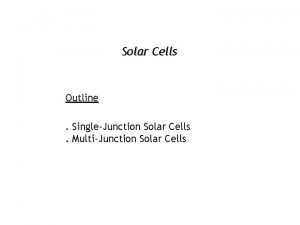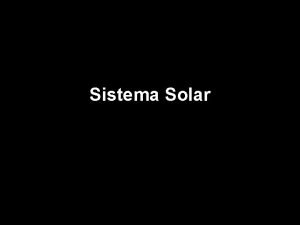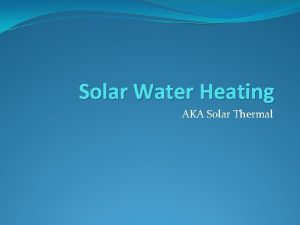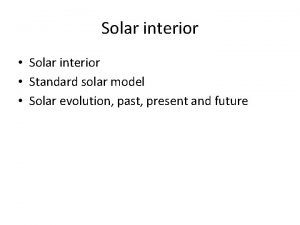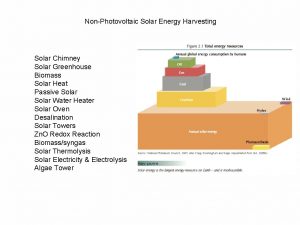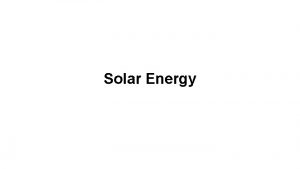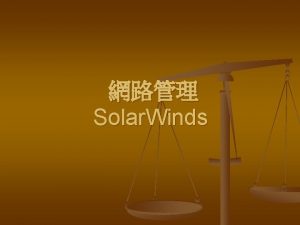Intro to the Solar System The Solar System






























- Slides: 30

Intro to the Solar System

The Solar System

Contents of the Solar System • Sun • Planets – 9 known (now: 8) – Mercury, Venus, Earth, Mars (“Terrestrials”) – Jupiter, Saturn, Uranus, Neptune (“Jovians”) – Pluto (a Kuiper Belt object? ) • Natural satellites (moons) – over a hundred • Asteroids and Meteoroids – 6 known that are larger than 300 km across – Largest, Ceres, is about 940 km in diameter • Comets • Rings • Dust

Size matters: radii of the Planets

Sun: Jupiter: Earth: Moon = 110: 11: 1: 1/4

The Astronomical Unit • A convenient unit of length for discussing the solar system is the Astronomical Unit (A. U. ) • One A. U. is the average distance between the Earth and Sun – About 1. 5 108 km or 8 light-minutes • Entire solar system is about 80 A. U. across

Sky Gazer • Watch the solar system “from above” in this computer simulation • Observe how all the planets move in a plane • See how far out the outer planets are!

The solar system is a disk, not a sphere

The Terrestrial Planets • Small, dense and rocky Mercury Mars Venus Earth

The Jovian Planets • Large, made out of gas, and low density Saturn Jupiter Uranus Neptune

Asteroids, Comets and Meteors Debris in the Solar System

Asteroids • Most asteroid orbits are situated between Mars and Jupiter

Asteroid Discovery • First (and largest) Asteroid Ceres discovered New Year’s 1801 by G. Piazzi, fitting exactly into Bode’s law: a=2. 8 A. U. • Today more than 100, 000 asteroids known • Largest diameter 960 km, smallest: few km • Most of them are named • about 20 of them are visible with binoculars

Most asteroids are very small

Comets - Traveling Dirty Snowballs • Small icy bodies, “dirty snowballs” • Develops a “tail” as it approaches the Sun

Comet Anatomy • Tail may be up to 1 A. U. long • Ion tail points away from sun

Shapes Comet Giacobini. Zinner (1959) • Ion tail 500, 000 km long • Coma: 70, 000 km across Comet Hale-Bopp (1997) • Tail 40° long as seen from earth

Halley’s Comet – a typical Comet • Highly eccentric orbit, inclined substantially

Halley’s Comet – Now and then • Halley’s Comet in 1910 • Top: May 10, 30° tail • Bottom May 12, 40° tail • Halley’s Comet in 1986 • March 14, 1986

Comet Shoemaker-Levy 9 Headed for Jupiter…

Impact on Jupiter

Meteors and Meteorites • Small particles that strike the atmosphere • Come from fragments of asteroids, Moon, Mars, comets • Strike the earth all the time (“meteorites”) – High speed means lots of energy released on impact

Meteors, Meteroids and Meteorites • A Meteor is a sudden strike of light in the night sky • A Meteoroid is a small asteroid, less than 100 m in diameter • A Meteorite is any piece of interplanetary matter that survives the passage through Earth’s atmosphere and lands on Earth’s surface

Meteor Showers – caused by comets Radiant Quadrantids (QUA) Lyrids (LYR) Eta Aquarids Beta Taurids Delta Aquarids Perseids (PER) Draconids Orionids (ORI) Taurids Leonids (LEO) Geminids (GEM) Duration Dec. 28 -Jan. 7 Apr. 16 -25 Apr. 21 -May 12 June 30 July 25 -31 Aug. 10 -14 Oct. 6 -10 Oct. 15 -29 Oct. 12 - Dec 2 Nov. 14 -20 Dec. 6 -19

Impact on Earth • Most probably caused the extinction of the dinosaurs

Impact Craters • Barringer Crater, AZ 0. 8 mi diameter, 200 yd deep; produced by impact about 25, 000 years ago • Quebec's Manicouagan Reservoir. Large meteorite landed about 200 million years ago. The lake, 45 miles in diameter, now fills the ring.

Tunguska • ~30 m body struck Siberia in 1908 • Energy equal to that of a 10 Megaton bomb! • Detonation above ground; several craters

2013: Siberia Again! • 1000 people injured as 20 m rock strikes • Explodes about 20 km overhead • 16 hours before known non-fatal asteroid encounter

Frequency of Impact Events

Formation of the Solar System • Features to explain: – – – – – planets are far apart, not bunched together orbits of planets are nearly circular orbits of planets lie mostly in a single plane directions of revolution of planets about Sun is the same, and is the same as the direction of the Sun's rotation directions of rotation of planets about their axes is also mostly in the same direction as the Sun's (exceptions: Venus, Uranus, Pluto) most moons revolve around their planets in the same direction as the rotation of the planets differentiation between inner (terrestrial) and outer (Jovian) planets existence and properties of the asteroids existence and properties of the comets
 Solar system intro
Solar system intro Wholesale solar power panel
Wholesale solar power panel What is an inexhaustible source of energy
What is an inexhaustible source of energy The digestive system introduction
The digestive system introduction Digestive system intro
Digestive system intro Arc system intro
Arc system intro Hát kết hợp bộ gõ cơ thể
Hát kết hợp bộ gõ cơ thể Slidetodoc
Slidetodoc Bổ thể
Bổ thể Tỉ lệ cơ thể trẻ em
Tỉ lệ cơ thể trẻ em Chó sói
Chó sói Tư thế worm breton
Tư thế worm breton Chúa yêu trần thế alleluia
Chúa yêu trần thế alleluia Môn thể thao bắt đầu bằng chữ đua
Môn thể thao bắt đầu bằng chữ đua Thế nào là hệ số cao nhất
Thế nào là hệ số cao nhất Các châu lục và đại dương trên thế giới
Các châu lục và đại dương trên thế giới Công của trọng lực
Công của trọng lực Trời xanh đây là của chúng ta thể thơ
Trời xanh đây là của chúng ta thể thơ Cách giải mật thư tọa độ
Cách giải mật thư tọa độ Phép trừ bù
Phép trừ bù độ dài liên kết
độ dài liên kết Các châu lục và đại dương trên thế giới
Các châu lục và đại dương trên thế giới Thể thơ truyền thống
Thể thơ truyền thống Quá trình desamine hóa có thể tạo ra
Quá trình desamine hóa có thể tạo ra Một số thể thơ truyền thống
Một số thể thơ truyền thống Bàn tay mà dây bẩn
Bàn tay mà dây bẩn Vẽ hình chiếu vuông góc của vật thể sau
Vẽ hình chiếu vuông góc của vật thể sau Nguyên nhân của sự mỏi cơ sinh 8
Nguyên nhân của sự mỏi cơ sinh 8 đặc điểm cơ thể của người tối cổ
đặc điểm cơ thể của người tối cổ V cc
V cc Vẽ hình chiếu đứng bằng cạnh của vật thể
Vẽ hình chiếu đứng bằng cạnh của vật thể
